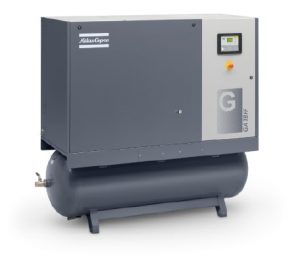When choosing an air compressor for a screen printing shop, you’ll be looking to purchase either a reciprocating air compressor or a rotary air compressor. In a reciprocating air compressor, a piston moves up and down to increase the air pressure. Two rotors perform the work in a rotary compressor, compressing the air.
A reliable source of compressed air is crucial for achieving high-quality screen printing with a pneumatic press.
A rotary screw compressor can be a good choice for a screen printing shop’s pneumatic needs.
Rotary air compressors can be more potent than reciprocating air compressors. However, many reciprocating air compressors are capable of operating a screen printing press. Rotary compressors provide continuous air pressure, whereas the pressure from a reciprocating compressor is intermittent. Additionally, reciprocating compressors tend to be noisier.
Rotary compressors typically require less maintenance and have longer lifespans than reciprocating air compressors; however, reciprocating air compressors are generally more cost-effective.
A reliable and perfect air compressor for screen printing machines can ensure high-quality screen printing. A printer might need to choose a suitable air compressor for the press.
To operate an automatic screen printing machine with full power, a screen printing company requires a reliable air compressor, which may necessitate additional equipment. If you can’t make the right choice for a suitable air compressor, your press can act unnaturally. Thus, it damages the quality of your work.
Follow the steps below to buy the Perfect Air Compressor.

- Power measurement for your press
- Select the category of the compressor.
- Other requirements for the compressor
- Using a chiller to control the air compressor.
- Hire Professionals to set up the machine and compressor.
Power Measurement
If you own a screen printing company, shop, or business, consider purchasing a compressor with sufficient power to operate your screen printing press. An air compressor that has 7.5 horsepower is suitable for screen printing equipment.
On the other hand, your press also requires Cubic Foot per minute (CFM) output. Your press manufacturer will provide CFM, which may differ from one piece of equipment to another.
Select the Category of the Compressor
You can choose between a rotary compressor and a reciprocating air compressor for your screen printing press. A piston goes up and down to increase the air pressure of the reciprocating compressor. On the other hand, the rotary compressor has two rotors.
The rotary compressor compresses air as the rotor runs. The rotary compressor is the best choice for your press. Compared to the rotating and reciprocating compressors, the rotary is more powerful.
You may find many automatic screen printing machines running with the reciprocating compressor. While the rotary compressor gives you air continuously, the reciprocating compressor gives you a break. Reciprocating also makes noise.
A rotary compressor is long-lasting, and you have to afford less to maintain it than a reciprocating compressor. However, the price of reciprocating is less than that of a rotating air compressor.
Other Requirements for the Perfect Air Compressor
There are a few additional requirements to consider when purchasing the perfect air compressor. The compressors require oil or lubricants to lubricate their parts as they rotate or move. Splash or pressure lubrication may be the choice for the reciprocating compressor. To run your screen printing machine smoothly, you must continuously put oil in the rotary compressor.
Regarding the air compressor, there is another consideration to consider. That is the heat, and it can cause a massive loss of your screen printing machine. Use water to cool the reciprocating compressor. However, there are also some environmentally friendly and air-cooled compressors.
You can use them too, as they are easy for your business. In the case of the rotary compressor, the oil serves as both the lubricant and the coolant. Finding any rotary air compressor with a water-based cooling system is challenging.
Using a Chiller to Control the Air Compressor in an Automatic Screen Printing Machine
Heat and water booths are the byproducts of the air compressor. Water can damage your screen printing press as it seeps into the system.
Adding a chiller or aftercooler to the air compressor is an excellent way to remove the water generated by the compressor. The chillers are outfitted between the air storage tank of the compressor and the compressor itself.
The chillers reduce the temperature of the compressed air and cause the water to condense by applying force. Thus, the chiller prevents the water from reaching the system and the press storage.
Hire the Professionals to Set up the Machine and Compressor
You have the air compressor and screen printing equipment in hand to get started with your business. Now you need to consider hiring a skilled individual with extensive experience in air compressors.
A professional contractor can install the air compressor properly with your new digital screen printing machine or automatic press. A contractor must alter the electric outlets and route the gas or electrical lines during the installation of the compressors.
You may need to ensure that the air compressor supplies adequate air to your screen printing press. Your contractor must provide the proper water line running to the air compressor and the air cooler. When purchasing new screen printing equipment, ensure it comes with an air compressor. It would be better to buy a press with the air compressor fully installed.
There are also many ways to decide to buy an air compressor for your press. However, it is wise to follow the manufacturer’s recommendations for the air compressor to ensure the proper installation of the new screen printing machine.
Learn more:
Zeny Heat Press 12″ x 15″ Pro: Best T-Shirt printing machine Reviews 2017
How to Control the Printing Quality of a Screen Printing Press.
7 Beginner’s Guides to Buy an Automatic Screen Printing Machine

Leave a Reply
You must be logged in to post a comment.